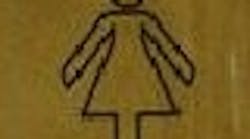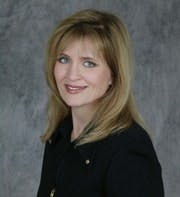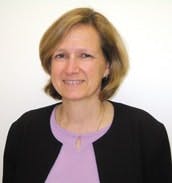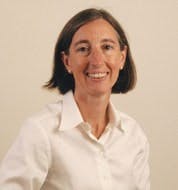That was then—the early 1980s. This is now. If that prejudice still exists, nobody’s saying it out loud. Good engineers are too hard to find.
But engineering is still a boys’ club. In Control’s 2007 Salary Survey, 6.4% of the respondents were women. Best estimates are that 10% of the engineers on the job are female—up from about 5% in 1983, according to IEEE. The chances are growing that at some point at least one woman will be on your engineering team.
Kim Miller Dunn, director of sales development and support at Emerson Process Management, and 2008 president of ISA.
What should you expect when it happens? To find out, I interviewed an even dozen successful women engineers. They are CEOs, entrepreneurs, chief engineers, team leaders and published authors. One, Kim Miller Dunn, director of sales development and support at Emerson Process Management, will take over as president of ISA next year. Their backgrounds are just as varied: Five have degrees in chemical engineering, three are double Es, one has an MS in analytical chemistry, one in computer science, one in biology and psychology, and one in—of all things—art history.
Here’s what they have to say about their professional experiences and what they wish the men they worked with knew about them as working partners.
Girls Like Us
Tina Lockhart, the new director of engineering at Moore Industries International, North Hills, Calif., presents the bottom line: “Women engineers are not really much different from men. They want to be treated as equals. I approach the job not as a woman, but as an engineer.”
All those interviewed say the most important traits for an engineer—the ones they look for in themselves and others—are gender-neutral.
“The classical things that you want to see in a good engineer are hard work, smarts, tenacity and creativity. It’s not gender-specific,” says Joy Weiss, electrical engineer and president and CEO at wireless sensor networking components provider Dust Networks, Hayward, Calif. “You’re really constantly in problem-solving mode, and the best are doing that in ways that result in newer capabilities and lower costs. It’s an ability to pull things together in a way they haven’t been done before.”
Schweitzer, currently a control systems engineer at Eastman Kodak in Rochester, N.Y., says a good engineer has to have integrity, honesty and a sense of humor—all gender-neutral characteristics.
What matters is results, says Kathleen Waters, principal engineer at biotech leader Genentech, San Francisco. “You have to have passion and want to own the problem. You have to show results,” she says.
But It’s Not Quite the Same
Having said that, the engineering workplace is different for a woman. “Men and women communicate in a different way. When you’re the only woman in the room, and you’re driving decisions, you have to make sure your message gets across,” says Waters, adding, “It may be a matter of establishing creditability. It may not be just a male/female thing.”
On the other side, male colleagues may be suspicious of women, says Angela Summers, president of SIS-Tech, a safety consulting firm in Houston, and a 2007 inductee into Control’s Process Automation Hall of Fame. “There’s a certain suspicion men have. They don’t understand where you’re coming from. Sometimes, I just have to get my agenda on the table first and say, ‘Look, there’s no ulterior motive here. I just want to get this job done in the best way.’ ”
Tina Lockhart, the new director of engineering at Moore Industries International.
Lockhart points to what she calls “the more consultative” style of women, saying that while certainly some men use that style, it comes more naturally to women, adding, “Men can sometimes be a little be more direct and outwardly forceful.”
She also thinks women tend to be better at multitasking and at “not always thinking like an engineer. Having been involved with customers and sales, I think it’s important to be able to translate engineering language for others.”
Alicia Bauer, director of global marketing for control systems and products at ABB, Wycliffe, Ohio, concurs. “I don’t try to look or talk tough. I can bring other gifts. I can explain tech to non-techies. I don’t know if that’s a female skill or an Alicia skill.”
Dr. Bianca Scholten, a partner at consultancy Ordina Technical Automation, the Netherlands, says it’s a personal struggle for women to make sure their accomplishments are acknowledged. “Culturally men are allowed to say they are good at their jobs. They can be overtly proud of themselves. When a woman says she is good at something, she is seen as arrogant, especially by other women.”
Weiss adds, “I think appropriate self-promotion is something women are less inclined to do.”
Lockhart agrees that “it can take people aback” if a woman is forceful. “It’s a balance between being professional and assertive. My approach has always been to sit, listen, think, and absorb rather than just jumping in. If someone doesn’t hear what I’m saying, I’ll repeat. I want to make sure everyone has time to say something, but I make sure I do too. It’s a more consultative style, but having said that, we’re not always working in a democracy. ”
The Elephant in the Room
Sandra Vann, a technology specialist at Dow Chemical, Midland, Mich., says, “In manufacturing, a woman has to demonstrate she’s competent. A guy is assumed to be competent until he makes a mistake.”
This is what Schweitzer calls “the unspoken prejudice of ‘can a woman possibly be qualified?’ ” That is an issue women face “every minute of our professional lives, ” she says.
Janice Abel, director of marketing for pharmaceuticals and biotechnology at Invensys Foxboro, Foxboro, Mass., says when she came on board at what was then the Foxboro Company, the first question colleagues would ask was what degree she held, something that rarely happened to her male counterparts. “I had to prove my credentials in a way that the guys didn’t,” she says.
Women may also carry the added burden of feeling responsible for their younger counterparts. “It’s the idea that if I make a mistake, it’s not just me. It reflects on the other women behind me,” says Schweitzer, adding that this lack of confidence may be a function of experience as well as gender. “The younger you are and the newer you are in your workplace, the higher the risk. After building a solid reputation over time, both I and my colleagues view an occasional mistake as a learning opportunity. Now I can say, ‘Well, I got that wrong. Let’s fix it and move on.’ ”
Not One of the Guys
One of the biggest frustrations for women engineers is their inadvertent exclusion from the community. “There’s this thing that happens when you walk into a room,” says Schweitzer. “The conversation may suddenly stop.”
Sometimes, she adds, it’s a matter of the men attempting to be courteous. “They’ll say, ‘You weren’t supposed to hear that,’ meaning they were telling a story they think might be inappropriate for me to hear. When that happens, I thank them. I try to positively reinforce that awareness.”
But Invensys’ Abel says that when men suddenly stop talking she enters the room, questions arise. “Was it a dirty joke? Just some guy thing? Something they don’t want me to know? What? Are these guys my peers or not?”
Sometimes bridging this gap is as simple as sharing a sandwich, Vann says. “You can get a lot by going to lunch. It shouldn’t be the boys and girls going separately. There should be that interaction on a personal level, which makes it easier to work together.”
The Line
Which brings us to the complicated issue of “The Line,” the business of maintaining that delicate balance between being friendly and inviting inappropriate behavior, between wanting to be “just one of the guys” and sending the wrong messages.
The solution, say these women, is simple, if not always easy—be professional; be yourself; dress professionally; act professionally—and make the line a very hard one.
“I was extremely professional and extremely knowledgeable about my job,” says Bauer. “I was always focused on work, and never talked about my personal life at work or with customers. At one job I had, they never even knew I was married. My whole goal has been for my being a woman not to be a factor. I don’t want them to think of ‘that girl in marketing.’ I want it to be my performance they remember.”
Diana Bouchard, formerly of the Pulp and Paper Research Institute of Canada (Paprican) and now a freelance technical editor.
It’s Not So Bad
In spite of such challenges, these women all say their experience working with men has been largely positive. With some spectacular exceptions—one admitted to being groped in an elevator and another got nasty emails when she became pregnant—their male colleagues have been supportive.
Diana Bouchard, formerly of the Pulp and Paper Research Institute of Canada (Paprican) and now a freelance technical editor, says, “I encountered very little overt or intentional discrimination over my career. More of it is unintentional and unconscious—habits of the mind that slot women and other people into categories and make assumptions about them.”
Sheri Worthington, president of Telesian Technology, a high-tech service provider, says, “I’ve been blessed with a great crew of male associates over the years. They treated me fairly. If I did a good job, they let me know. If I mucked up, they let me know!”
At the same time, these engineers see the glass ceiling. “The old boy network is still in place,” says Schweitzer.
“It depends a lot on the company you work for,” adds Bauer. “There are a lot of good examples of technical women running companies, but at some companies it’s going to take women longer. It can be a very white male-centric world. People still want to hire people that look like them.”
Part of the problem is not overt discrimination, but demographics.
“I’ve seen a number of glass ceilings for women, but I don’t know as I’ve seen one in technology. The challenge is more that we don’t have a lot of women in engineering in the first place,” says Worthington. “Unfortunately, I don’t see more girls getting interested in science and engineering in high school or college.”
It’s also true that the reality of discrimination can be hard to sort out. Weiss observes, “One of the ways gender gets used is not as a gender bias per se. The gender discrimination comes because of the rivalry. Even if, culturally, it’s a place that doesn’t have a particular bias, people will try things to get in your way, and that’s one place where women get tripped up. If you’re ambitious and moving up the ladder, gender is something that can be used to trip you up.”
Still, being a woman engineer is getting easier. “The under-40s are completely at ease with women as managers and coworkers,” says Scholten. “Their girlfriends and wives all work, and they’re used to it. The older men can be gallant, but some can be old-fashioned and prejudiced about women in technical jobs and management.”
Joy Weiss, president and CEO at Dust Networks.
Do It Again
All but two of these women said, in spite of everything, they would become engineers again. Those who wouldn’t—or wouldn’t recommend that their daughters enter the field—say it’s not because of gender bias, but the realities of the profession.
Summers says, “I wouldn’t tell them to go into engineering. You’re in school a long time to get a job you may not be able to keep no matter how good you are. You can go into medicine or law where you’re not going to face the salary cuts. There’s no guarantee this will be a good job.”
On the other hand, Weiss says, engineering “has served me very well. I learned a lot. It’s an extraordinary pedigree I didn’t appreciate at the time. It’s a fantastic opportunity for women.”
“I’ve had a blast in my career,” says Dunn, finishing with her favorite story about how her children see the future of women in engineering. “I went to one of my sons’ schools to talk about National Engineering Week, and one little boy said, ‘You can’t be an engineer. You’re a girl.’ And my seven-year-old said, ‘Where did you get a bonehead idea like that?’ So there’s hope.”
Here Are the Engineers We Interviewed for this Story
Janice T. Abel is director, marketing for the pharmaceutical and biotechnology industries for Foxboro, Invensys Process Systems. She holds a bachelor’s degree in chemistry from Clark University, Worcester, Mass., and a master of science degree in chemical engineering from Worcester Polytechnic Institute, Worcester, Mass.
Alicia Bauer is director of global marketing, control systems and products for ABB. She holds a bachelor’s degree in electrical engineering from Valparaiso University, Valparaiso, Ind.
Diana Bouchard, a freelance technical writer and editor, formerly with formerly of the Pulp and Paper Research Institute of Canada (Paprican), holds degrees in mathematics and computer science from McGill University, Montreal.
Kim Miller Dunn is director of sales development and support with Emerson Process Management. She will take over as the president of ISA in 2008. She has a degree in chemical engineering form California State University, Long Beach.
Tina Lockhart is director of engineering at Moore Industries. She has a bachelor of science degree in electrical engineering from Brunel University in the U.K.
Dr. Bianca Scholten is a partner at Ordina Technical Automation, Rosmalen, Netherlands. She is the author of The Road to Integration – A Guide to Applying the ISA 95 Standard in Manufacturing. She has a degree in art history for the University of Utrecht.
Dawn Schweitzer, a control systems engineer and engineering management specialist at Eastman Kodak, holds a degree in chemical engineering from Rensselaer Polytechnic University, Troy, N.Y. She also serves on the Control editorial advisory board.
Dr. Angela Summers, PE, is president of her own company, SIS-Tech. She is a specialist in industrial safety. She holds a bachelor of science degree in chemical engineering from Mississippi State University, a master of science degree in environmental engineering from Clemson University, Clemson, S.C., and a doctorate in chemical engineering from the University of Alabama, Tuscaloosa, Ala. She is a recipient of the 2005 ISA Albert F. Sperry Award and this year was inducted into the Control Process Automation Hall of Fame.
Sandra Vann is a technology specialist at the Dow Latex Technology Center in Midland, Mich. She has a degree in chemical engineering from the University of Wisconsin at Madison.
Kathleen Waters is the principal engineer at biotech company Genentech, San Francisco. She has a master’s degree in chemical engineering. She is current the vice chairperson on the ISA S88 standards committee. In 2006, she was the first woman inducted into the Control Process Automation Hall of Fame.
Joy Weiss is president and CEO at Dust Networks. She is a past president and general manager of Nortel’s Network Management division, past president and CEO of Esker Software and of microdisplay vendor Inviso. She holds a bachelor’s degree in electrical engineering from MIT.
Shari Worthington, president of Telesian Technology, holds a bachelor’s degree in biology and psychology from St. Lawrence University, Canton, N.Y., a master’s degree in psychology from Framingham State College, Framingham, Mass., and an MBA from Babson College, Babson Park, Mass. She is the co-author of e-Business in Manufacturing: Putting the Internet to Work in the Industrial Enterprise.
Want more? Check out:
Latest from Asset Management

Leaders relevant to this article:








